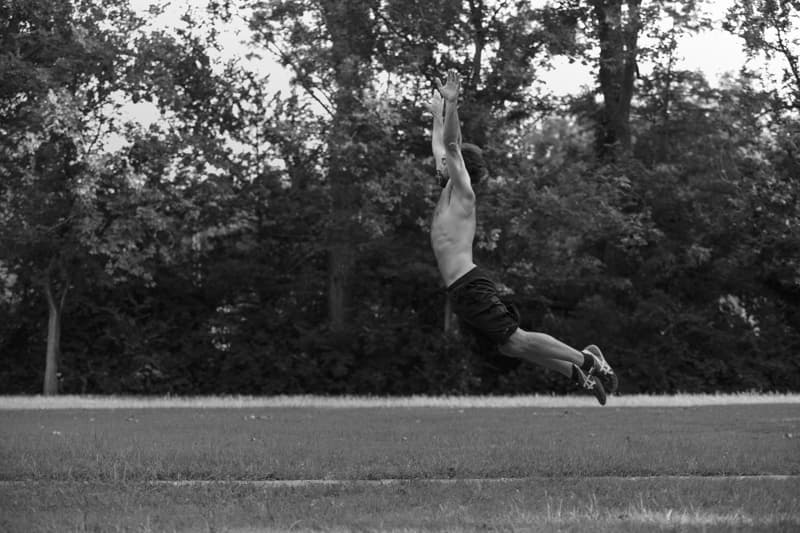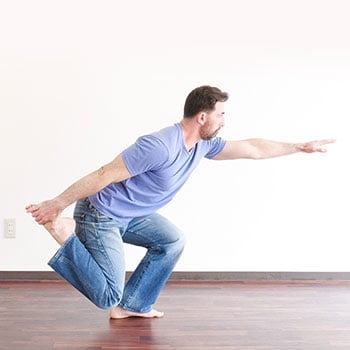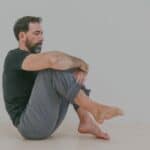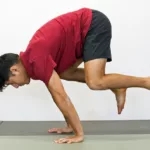Jumping is more than just how high you can leap; it’s a fundamental athletic movement that showcases how well you can control and move your body. And it’s well worth the effort to get better at it! There’s a great satisfaction of feeling powerful and in control with every jump, knowing that each leap is a testament to your strength, coordination, and agility.
Let’s get into it right away with the fundamentals of jumping technique. Strength and power are absolutely a part of it, but the heart of jumping well and knowing how to do it makes it transfer to all the rest of your physical activities. It’s a skill you need to practice and this video shows you exactly how to do that.
Jump Tutorial: How to Jump with the Best Technique
So, let’s talk technique and help you start incorporating jump training into your routine.
There are many different types of jumps we could cover, but the purpose of this video is to show you the most practical variations that will help you build up the complexity level and power of your jumps over time.
| Jump Variations | Key Points |
|---|---|
| Basic Jump | • Start from a quarter squat position and swing arms up for momentum. • Keep the head in neutral position, and land softly and with control, keeping the knees bent. |
| Precision Jump | • Start on a determined point and look at the target you will be aiming to land on. • Spot the landing point with your eyes and sit the butt back slightly to counterbalance yourself for the landing |
| Broad Jump | • The focus here is opening up the body as much as possible and jumping as far as you can while being able to control your landing. • As you jump, drive the hips forward, open your shoulders overhead, and keep the head neutral. • Land softly with bent knees. |
| Side Jump | • Follow the same cues as the basic jump (starting in quarter squat, lifting arms up overhead, etc), but jump to the side. • Land softly, with knees bent. |
| Single Leg Bounds | • For this moving variation, you'll jump from one leg to the other as you move forward at an angle. • Reach forward and down to the ground as you land. |
| 180-Degree Jump | • Start the same way as you did with the basic jump, but keep your arms overhead and turn your head to turn your body 180 degrees. • Focus on landing in the same spot (just facing the other direction) as your starting position. |
Why You Need to Develop Your Jump Skills
Jump training–if approached as a skill–is something most people can benefit from. David Lee Roth said it best: “Go ahead and jump!” 😉

You can see from the extremely historically accurate graphic above that jumping has been kind of a big deal for, well, forever. But these days, most people just use jumps as a conditioning exercise, and there’s a lot of potential benefit that gets wasted that way.
Skill-based jump training builds power, precision, and full body coordination.
Sure, this is obvious if you play a lot of basketball or do gymnastics, but that power applies to a wide range of other athletic and real life situations too. Running, climbing, lifting things quickly, martial arts training, bounding up the stairs–these are all situations where having a good level of power, precision, and coordination will come in handy.
Power, like anything else, tends to diminish as we get older unless we specifically train for it. And loss of power means a limited ability to do the things you want to do, with ease. Plus, power makes your body a whole lot more resilient, and that’s important when shit happens (which it definitely will at some point).
This is exactly why we have jumps as a fundamental exercise in our Integral Strength program.
Breaking Down Proper Jump Technique
There’s a lot that goes into a proper, full-range jump. In this image, you can see the level of complexity involved in a jump done with precision and power:
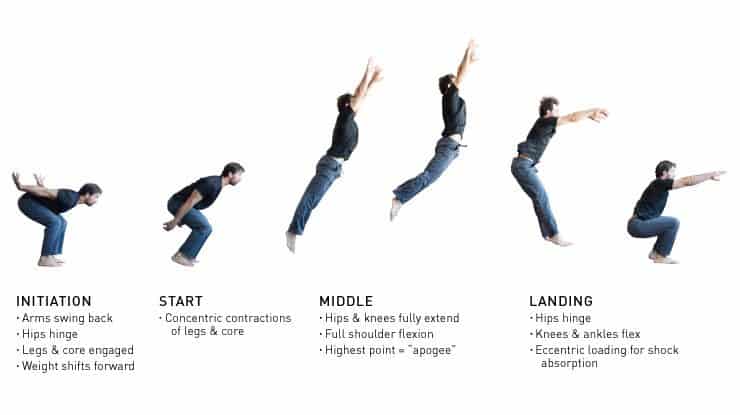
5 Phases of Proper Jump Technique
- Loading: As you prepare to initiate the jump, the arms swing back and the hips hinge. There’s eccentric loading of the glutes, hamstrings, quads, back extensors, and calves. The core muscles begin bracing, and weight shifts to the balls of your feet.
- Initiation: Where the initiation phase engaged the muscles eccentrically, as you start the jump, you’ll contract those extensor muscles in the hips and legs explosively while opening up the hip-flexors. This action of the hips, knees, and ankles is called “triple extension.”
- Extension: In the middle of the movement, the hips and shoulders open as the arms swing up toward the ears to create the maximum possible momentum. At the highest point in the jump cycle, the apogee, you’ll have full body extension.
- Descent: After the apogee, the body begins to prepare for controlled landing. The hips hinge, knees flex, and ankles plantarflex.
- Absorption: The landing resembles the start position, but now you’ll have eccentric loading for shock absorption. It can help to imagine pulling the ground up into your feet.
That’s quite a bit different from your typical high-rep “finisher” routine, huh?
And there’s a good reason for that. Skills, by definition, have some level of complexity to them, and jumps, when approached in this way, can be particularly complex, as you can see from the many details that go into a full range jump.
The Golden Rule of Exercise Intensity

If you’re using jumps as an intense conditioning exercise, you automatically won’t be able to practice them as a complex skill.
The complexity of skills you can safely perform is inversely proportional to the intensity at which you can perform them.
In other words, the more complex the movement pattern, the less intensely you can do it without risking injury. And as we’ve shown, good jump technique is plenty complex.
When you do rep after sloppy rep of box jumps or other highly complex jump variations, it’s a recipe for injury and you won’t build much power that way. Yeah, doing hundreds of crappy jumps will get you sweaty and out of breath, but will it actually make you better at what jumps are really good for?
Nope.
So it’s worth slowing your roll a bit to get better 🙂
Exercises for Jump Development
Like everything, jumps are a combination of strength, flexibility, and control, and though you might be able to develop those things simply by doing lots of jumps, it’s not the most efficient path.
In general, it pays to assess and address your weakest links first.
Recommended Attribute Development for Jumping:
- Strength: Squats and L-sits
- Flexibility: Hip Mobility
- Control: Locomotive Coordination Drills
As you develop the basic attributes for a better jump, you can also apply them by practicing your jump technique.
Troubleshooting Your Jump Technique
Along with those attributes, you may notice some sticking points in your technique. If you feel like you need a bit of extra work to get them feeling better, take a look at these resources on the most common technique issues.
Resources for Common Jump Problems
- Limited hinge at the hips: Hip Mobility Routine
- Lack of strength in the takeoff: Bodyweight Leg Strength Exercises
- Lack of explosiveness: Hip Strength & Mobility Exercises
- Knee discomfort: Knee Health Exercises
- Poor balance or position in landing: Foot & Ankle Exercises
Spend some time addressing the aspects you struggled with most, and your jump training will be far more effective and powerful.
How Jumps Work Within a Training Framework
For a skill with so many benefits, jumping doesn’t get its due. It’s usually an afterthought in programming and taught just as a way to get your heart rate up and leave you feeling like you got a “good workout.”
The truth is, jumping works really well in the context of a workout, but only if it’s practiced as a skill, and only if the other exercises in the session are carefully chosen to help support you in learning that skill.
We include jumps in our Integral Strength program, in a context that makes for optimal skill building and power generation. Integrated, full body movements mean that the work you put into your workouts will directly help you outside of the gym/workout space, so that you can do all the things you want and need to do.
Build your Jumping Strength for All The Activities You Love
Unlock your full potential with Integral Strength, where you’ll not only train your jumps but also master complementary skills that build power, precision, and strength for every aspect of your life. Don’t just jump higher—move better in everything you do.
